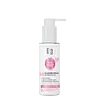What's inside
What's inside
 Key Ingredients
Key Ingredients

 Benefits
Benefits

 Concerns
Concerns

 Ingredients Side-by-side
Ingredients Side-by-side

Water
Skin ConditioningGlycerin
HumectantCaprylic/Capric Triglyceride
MaskingPolyglyceryl-4 Caprate
EmulsifyingTripelargonin
EmollientGlyceryl Stearate Citrate
EmollientGlycereth-7 Caprylate/Caprate
EmulsifyingCetearyl Alcohol
EmollientPassiflora Incarnata Seed Oil
Skin ProtectingSclerocarya Birrea Seed Oil
HumectantAvena Sativa Kernel Extract
AbrasiveInulin
Skin ConditioningAlpha-Glucan Oligosaccharide
CleansingTocopheryl Acetate
AntioxidantCarbomer
Emulsion StabilisingPhenoxyethanol
PreservativeEthylhexylglycerin
Skin ConditioningSodium Hydroxide
BufferingWater, Glycerin, Caprylic/Capric Triglyceride, Polyglyceryl-4 Caprate, Tripelargonin, Glyceryl Stearate Citrate, Glycereth-7 Caprylate/Caprate, Cetearyl Alcohol, Passiflora Incarnata Seed Oil, Sclerocarya Birrea Seed Oil, Avena Sativa Kernel Extract, Inulin, Alpha-Glucan Oligosaccharide, Tocopheryl Acetate, Carbomer, Phenoxyethanol, Ethylhexylglycerin, Sodium Hydroxide
Water
Skin ConditioningGlycerin
HumectantSodium Cocoyl Isethionate
CleansingPolyglyceryl-4 Oleate
EmulsifyingGlyceryl Stearate
EmollientCetearyl Alcohol
EmollientSorbitol
HumectantCocoglycerides
EmollientSqualane
EmollientPanthenol
Skin ConditioningSodium Hyaluronate
HumectantPhosphatidylserine
Emulsion StabilisingGlycolipids
Skin ConditioningPhospholipids
Skin ConditioningCeramide NP
Skin ConditioningCeramide AP
Skin ConditioningPhytosphingosine
Skin ConditioningCholesterol
EmollientCeramide EOP
Skin ConditioningEthylhexylglycerin
Skin ConditioningCaprylic/Capric Triglyceride
MaskingSodium Lauroyl Lactylate
EmulsifyingHydroxypropyl Starch Phosphate
Microcrystalline Cellulose
AbsorbentXanthan Gum
EmulsifyingCellulose Gum
Emulsion StabilisingDisodium EDTA
Citric Acid
BufferingCarbomer
Emulsion StabilisingPhenoxyethanol
PreservativeWater, Glycerin, Sodium Cocoyl Isethionate, Polyglyceryl-4 Oleate, Glyceryl Stearate, Cetearyl Alcohol, Sorbitol, Cocoglycerides, Squalane, Panthenol, Sodium Hyaluronate, Phosphatidylserine, Glycolipids, Phospholipids, Ceramide NP, Ceramide AP, Phytosphingosine, Cholesterol, Ceramide EOP, Ethylhexylglycerin, Caprylic/Capric Triglyceride, Sodium Lauroyl Lactylate, Hydroxypropyl Starch Phosphate, Microcrystalline Cellulose, Xanthan Gum, Cellulose Gum, Disodium EDTA, Citric Acid, Carbomer, Phenoxyethanol
 Reviews
Reviews

Ingredients Explained
These ingredients are found in both products.
Ingredients higher up in an ingredient list are typically present in a larger amount.
This ingredient is an emollient, solvent, and texture enhancer. It is considered a skin-softener by helping the skin prevent moisture loss.
It helps thicken a product's formula and makes it easier to spread by dissolving clumping compounds.
Caprylic Triglyceride is made by combining glycerin with coconut oil, forming a clear liquid.
While there is an assumption Caprylic Triglyceride can clog pores due to it being derived from coconut oil, there is no research supporting this.
Learn more about Caprylic/Capric TriglycerideCarbomer is a polymer of acrylic acid. Its main role is to create a gel consistency.
A high amount of carbomer can cause pilling or balling up of products. Don't worry, most products contain 1% or less of carbomer.
Cetearyl alcohol is a mixture of two fatty alcohols: cetyl alcohol and stearyl alcohol. It is mainly used as an emulsifier. Emulsifiers help prevent the separation of oils and products. Due to its composition, it can also be used to thicken a product or help create foam.
Cetearyl alcohol is an emollient. Emollients help soothe and hydrate the skin by trapping moisture.
Studies show Cetearyl alcohol is non-toxic and non-irritating. The FDA allows products labeled "alcohol-free" to have fatty alcohols.
This ingredient is usually derived from plant oils such as palm, vegetable, or coconut oils. There is debate on whether this ingredient will cause acne.
Due to the fatty acid base, this ingredient may not be Malassezia folliculitis safe.
Learn more about Cetearyl AlcoholEthylhexylglycerin (we can't pronounce this either) is commonly used as a preservative and skin softener. It is derived from glyceryl.
You might see Ethylhexylglycerin often paired with other preservatives such as phenoxyethanol. Ethylhexylglycerin has been found to increase the effectiveness of these other preservatives.
Glycerin is already naturally found in your skin. It helps moisturize and protect your skin.
A study from 2016 found glycerin to be more effective as a humectant than AHAs and hyaluronic acid.
As a humectant, it helps the skin stay hydrated by pulling moisture to your skin. The low molecular weight of glycerin allows it to pull moisture into the deeper layers of your skin.
Hydrated skin improves your skin barrier; Your skin barrier helps protect against irritants and bacteria.
Glycerin has also been found to have antimicrobial and antiviral properties. Due to these properties, glycerin is often used in wound and burn treatments.
In cosmetics, glycerin is usually derived from plants such as soybean or palm. However, it can also be sourced from animals, such as tallow or animal fat.
This ingredient is organic, colorless, odorless, and non-toxic.
Glycerin is the name for this ingredient in American English. British English uses Glycerol/Glycerine.
Learn more about GlycerinPhenoxyethanol is a preservative that has germicide, antimicrobial, and aromatic properties. Studies show that phenoxyethanol can prevent microbial growth. By itself, it has a scent that is similar to that of a rose.
It's often used in formulations along with Caprylyl Glycol to preserve the shelf life of products.
Water. It's the most common cosmetic ingredient of all. You'll usually see it at the top of ingredient lists, meaning that it makes up the largest part of the product.
So why is it so popular? Water most often acts as a solvent - this means that it helps dissolve other ingredients into the formulation.
You'll also recognize water as that liquid we all need to stay alive. If you see this, drink a glass of water. Stay hydrated!
Learn more about Water